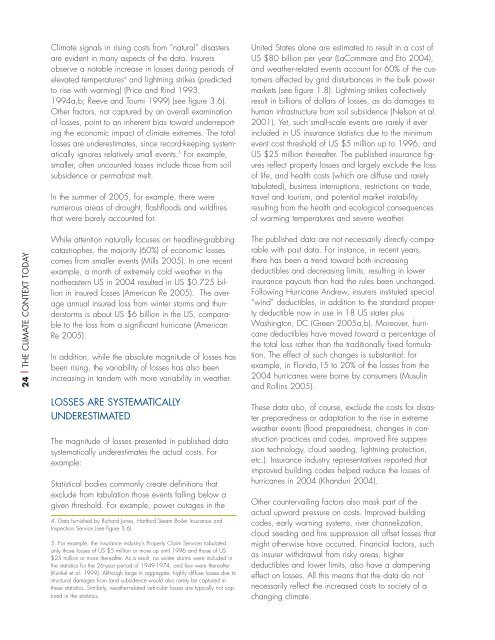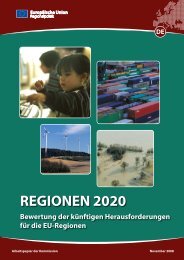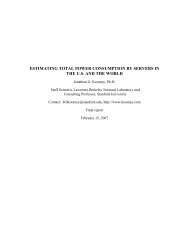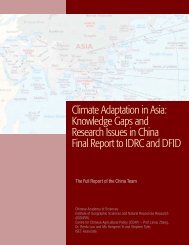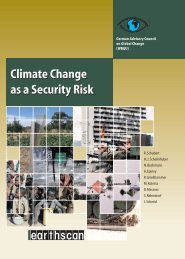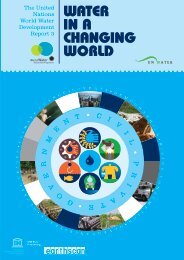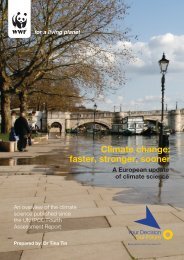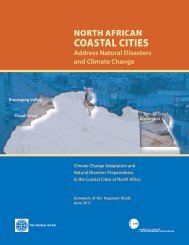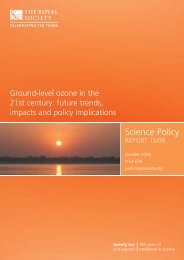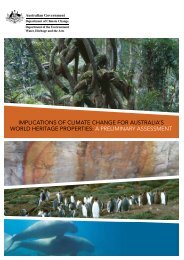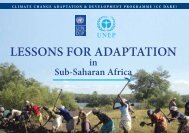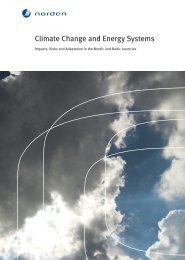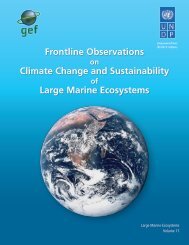Climate change futures: health, ecological and economic dimensions
Climate change futures: health, ecological and economic dimensions
Climate change futures: health, ecological and economic dimensions
Create successful ePaper yourself
Turn your PDF publications into a flip-book with our unique Google optimized e-Paper software.
<strong>Climate</strong> signals in rising costs from “natural” disastersare evident in many aspects of the data. Insurersobserve a notable increase in losses during periods ofelevated temperatures 4 <strong>and</strong> lightning strikes (predictedto rise with warming) (Price <strong>and</strong> Rind 1993,1994a,b; Reeve <strong>and</strong> Toumi 1999) (see figure 3.6).Other factors, not captured by an overall examinationof losses, point to an inherent bias toward underreportingthe <strong>economic</strong> impact of climate extremes. The totallosses are underestimates, since record-keeping systematicallyignores relatively small events. 5 For example,smaller, often uncounted losses include those from soilsubsidence or permafrost melt.In the summer of 2005, for example, there werenumerous areas of drought, flashfloods <strong>and</strong> wildfiresthat were barely accounted for.United States alone are estimated to result in a cost ofUS $80 billion per year (LaCommare <strong>and</strong> Eto 2004),<strong>and</strong> weather-related events account for 60% of the customersaffected by grid disturbances in the bulk powermarkets (see figure 1.8). Lightning strikes collectivelyresult in billions of dollars of losses, as do damages tohuman infrastructure from soil subsidence (Nelson et al.2001). Yet, such small-scale events are rarely if everincluded in US insurance statistics due to the minimumevent cost threshold of US $5 million up to 1996, <strong>and</strong>US $25 million thereafter. The published insurance figuresreflect property losses <strong>and</strong> largely exclude the lossof life, <strong>and</strong> <strong>health</strong> costs (which are diffuse <strong>and</strong> rarelytabulated), business interruptions, restrictions on trade,travel <strong>and</strong> tourism, <strong>and</strong> potential market instabilityresulting from the <strong>health</strong> <strong>and</strong> <strong>ecological</strong> consequencesof warming temperatures <strong>and</strong> severe weather.24 | THE CLIMATE CONTEXT TODAYWhile attention naturally focuses on headline-grabbingcatastrophes, the majority (60%) of <strong>economic</strong> lossescomes from smaller events (Mills 2005). In one recentexample, a month of extremely cold weather in thenortheastern US in 2004 resulted in US $0.725 billionin insured losses (American Re 2005). The averageannual insured loss from winter storms <strong>and</strong> thunderstormsis about US $6 billion in the US, comparableto the loss from a significant hurricane (AmericanRe 2005).In addition, while the absolute magnitude of losses hasbeen rising, the variability of losses has also beenincreasing in t<strong>and</strong>em with more variability in weather.LOSSES ARE SYSTEMATICALLYUNDERESTIMATEDThe magnitude of losses presented in published datasystematically underestimates the actual costs. Forexample:Statistical bodies commonly create definitions thatexclude from tabulation those events falling below agiven threshold. For example, power outages in the4. Data furnished by Richard Jones, Hartford Steam Boiler Insurance <strong>and</strong>Inspection Service (see figure 3.6)5. For example, the insurance industry's Property Claim Services tabulatedonly those losses of US $5 million or more up until 1996 <strong>and</strong> those of US$25 million or more thereafter. As a result, no winter storms were included inthe statistics for the 26-year period of 1949-1974, <strong>and</strong> few were thereafter(Kunkel et al. 1999). Although large in aggregate, highly diffuse losses due tostructural damages from l<strong>and</strong> subsidence would also rarely be captured inthese statistics. Similarly, weather-related vehicular losses are typically not capturedin the statistics.The published data are not necessarily directly comparablewith past data. For instance, in recent years,there has been a trend toward both increasingdeductibles <strong>and</strong> decreasing limits, resulting in lowerinsurance payouts than had the rules been un<strong>change</strong>d.Following Hurricane Andrew, insurers instituted special“wind” deductibles, in addition to the st<strong>and</strong>ard propertydeductible now in use in 18 US states plusWashington, DC (Green 2005a,b). Moreover, hurricanedeductibles have moved toward a percentage ofthe total loss rather than the traditionally fixed formulation.The effect of such <strong>change</strong>s is substantial: forexample, in Florida,15 to 20% of the losses from the2004 hurricanes were borne by consumers (Musulin<strong>and</strong> Rollins 2005).These data also, of course, exclude the costs for disasterpreparedness or adaptation to the rise in extremeweather events (flood preparedness, <strong>change</strong>s in constructionpractices <strong>and</strong> codes, improved fire suppressiontechnology, cloud seeding, lightning protection,etc.). Insurance industry representatives reported thatimproved building codes helped reduce the losses ofhurricanes in 2004 (Kh<strong>and</strong>uri 2004).Other countervailing factors also mask part of theactual upward pressure on costs. Improved buildingcodes, early warning systems, river channelization,cloud seeding <strong>and</strong> fire suppression all offset losses thatmight otherwise have occurred. Financial factors, suchas insurer withdrawal from risky areas, higherdeductibles <strong>and</strong> lower limits, also have a dampeningeffect on losses. All this means that the data do notnecessarily reflect the increased costs to society of achanging climate.


